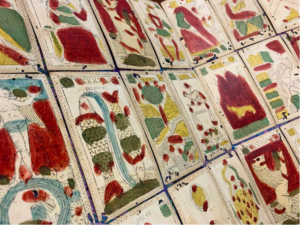The Game of Tarot Amid Fact and Fiction: Using Digital Maps to Trace Cultural Histories
by Meghan McGinley, Mellon Graduate Fellow, French & Italian
I initially conceived of my DH project “Mapping the Tarot: Game and Divination Across Time” as a means to trace the cultural histories of the game of tarot using ArcGIS, an online mapping tool that allows for interactive digital storytelling. In conjunction with the George Clulow-United States Playing Card Company Gaming Collection holding in Vanderbilt’s Special Collections, which houses a wealth of resources on the subject, I proposed to “correct” the popular narrative that views the tarot as having esoteric origins. In fact, the seemingly mystical cards have a secular beginning, initially invented as a tabletop card game in (more than likely) the court of Duke Filippo Maria Visconti of Milan in the 15th century.
However, as I continued to gather various data points—places, dates, card type, artist—I kept finding myself in a mass of fascinating tarot misinformation. While scholars have largely debunked these tall tales, I began to think that my initial plan of plotting the historically correct record read thin. Wouldn’t it be extraordinary, instead, to map the relationship between fact and fiction, to see where these lines, both real and imagined, come together or stray? With this revelation, it is now my intention to plot out the historical evolution of the cards alongside their identified sites of misinformation and to pinpoint the circumstances that incentivized deception.

At this point, I am also asking myself pivotal design questions. How do I make my digital map accessible to a general audience? How do I engage in a multiliterate modality, in which the visual and the textual engage with the spatial aspects of my map? How do I curate a wealth of information into digestible chunks that capture the imagination of my site users? Helen Farley’s A Cultural History of Tarot: From Entertainment to Esotericism presents, for example, four main subdivisions within the history of the cards: the Renaissance, the French Occult, the English Occult, and the New Age. This structure may serve as a model in which I unravel the false narratives surrounding the tarot at certain points in history. When Napoleon conquered Egypt, for instance, in the late 18th century, a potent strain of Egyptomania took hold of the French. Many cartomancers in the Hexagon, who had already claimed that tarot harbored ancient knowledge, invented elaborate stories that claimed the cards were originally of ancient Egyptian origin and, therefore, could unlock the mysteries of the future. This, as we know now, is far from the case.
By the end of my fellowship year, I’d like to produce a thoughtful contribution to the history of ideas surrounding the tarot, one that those inside and outside of the academy find compelling. I’d also like to think that the tracing of false narratives, generally speaking, using mapping technologies like ArcGIS can help one glean solutions to the problems of misinformation that abound in our current moment.
